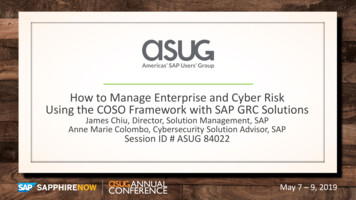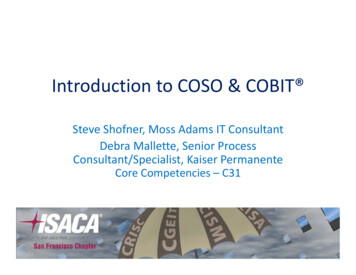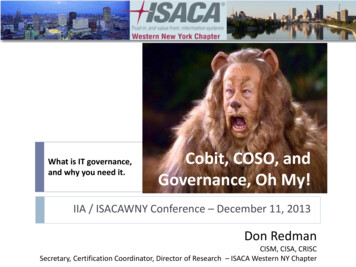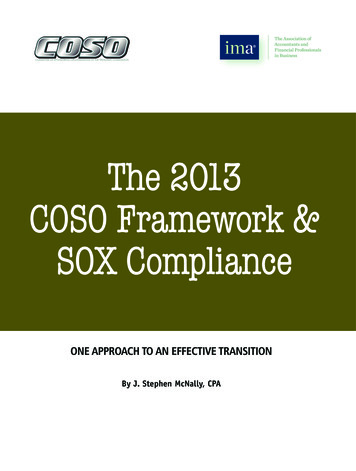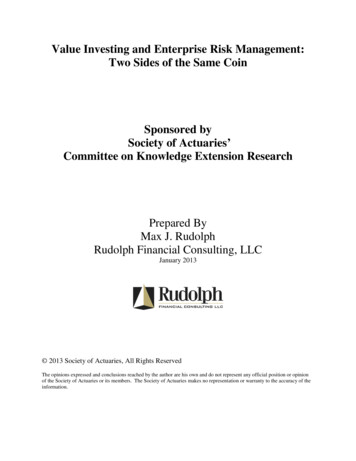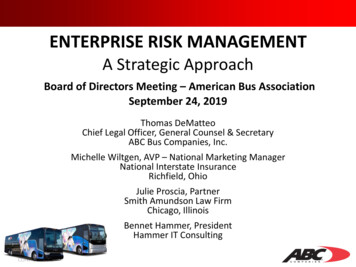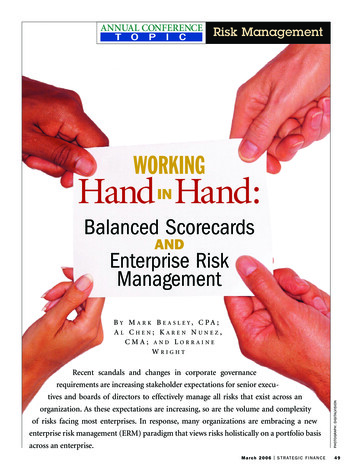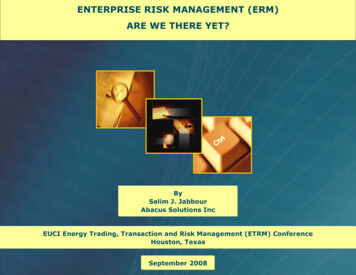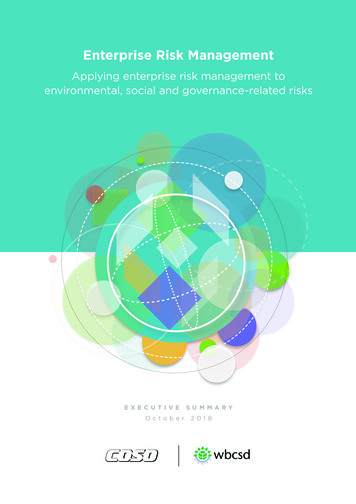
Transcription
Enterprise Risk ManagementApplying enterprise risk management toenvironmental, social and governance-related risksE X E C U TI V EO c to b e rS U M M A RY2 01 8
This document is an executive summary of Enterprise risk management—Applying enterprise risk managementto environmental, social and governance-related risks. This guidance is designed to apply to COSO’s enterpriserisk management (ERM) framework, Enterprise Risk Management—Integrating with strategy and performance.It addresses an increasing need for companies to integrate environmental, social and governance-related risks(ESG) into their ERM processes.Committee of Sponsoring Organizations of the Treadway Commission (COSO) Paul J. Sobel, COSO Chair Douglas F. Prawitt, American Accounting Association Charles E. Landes, American Institute of Certified Public Accountants Daniel C. Murdock, Financial Executives International Jeffrey C. Thomson, Institute of Management Accountants Richard F. Chambers, The Institute of Internal AuditorsWorld Business Council for Sustainable Development (WBCSD) Peter Bakker, President and CEO Peter White, Vice President and Chief Operating Officer Rodney Irwin, Managing Director, Redefining ValueThis project is funded by the Gordon and Betty Moore Foundation.About usOriginally formed in 1985, COSO is a voluntary private sector organization dedicated to providing thoughtleadership through the development of comprehensive frameworks and guidance on internal control, enterpriserisk management and fraud deterrence. COSO is jointly sponsored by the American Accounting Association(AAA), the American Institute of Certified Public Accountants (AICPA), Financial Executives International (FEI),the Institute of Management Accountants (IMA) and the Institute of Internal Auditors (IIA).For more information, visit COSO.org.WBCSD is a global, CEO-led organization of over 200 leading businesses working together to accelerate thetransition to a sustainable world. WBCSD helps make its member companies more successful and sustainableby focusing on the maximum positive impact for shareholders, the environment and societies.WBCSD member companies come from all business sectors and all major economies, representing acombined revenue of more than USD 8.5 trillion and 19 million employees. WBCSD’s global network of almost70 national business councils gives its members unparalleled reach across the globe. WBCSD is uniquelypositioned to work with member companies along and across value chains to deliver impactful businesssolutions to the most challenging sustainability issues.Together, WBCSD is the leading voice of business for sustainability: united by its vision of a world wheremore than 9 billion people are all living well and within the boundaries of the planet, by 2050.Visit wbcsd.org.The Gordon and Betty Moore Foundation fosters path-breaking scientific discovery, environmentalconservation, patient care improvements and preservation of the special character of theSan Francisco Bay Area. Visit Moore.org or follow @MooreFound. 2018, The Committee of Sponsoring Organizations of the Treadway Commission (COSO) and World Business Council for Sustainable Development(WBCSD). All Rights Reserved. Information may be freely shared but may not be used for commercial use without written permission.
Executive summaryIntroductionEntities, including businesses, governments and non-profits, face an evolving landscape of environmental,social and governance (ESG)-related risks that can impact their profitability, success and even survival. Giventhe unique impacts and dependencies of ESG-related risks, COSO and WBCSD have partnered to developguidance to help entities better understand the full spectrum of these risks and to manage and disclosethem effectively.The guidance is designed to help risk management and sustainability practitioners apply enterprise riskmanagement (ERM) concepts and processes to ESG-related risks.What are ESG-related risks?ESG-related risks are the environmental, social and governance-related risks and/or opportunities that mayimpact an entity. There is no universal or agreed-upon definition of ESG-related risks, which may also bereferred to as sustainability, non-financial or extra-financial risks.a Each entity will have its own definition basedon its unique business model; internal and external environment; product or services mix; mission, visionand core values and more. The resulting definition may be broad (for example, may include all aspects of theInternational Integration Reporting Council’s (IIRC) six capitals, discussed in Chapter 2) or narrow (for example,may include only a selection of priority environmental and social issues) and may evolve over time.For the purposes of the guidance, the term ESG-related risks encompasses the issues that are prominent oninvestors’ and other stakeholders’ agendas, such as those described by MSCI1 and Robeco2 in Table 1:Table 1: Definitions of ESGMSCI definitionRobeco definitionEnvironmentalClimate change, naturalresources, pollution andwaste and environmentalopportunitiesThe contribution an entity makes to climate change through greenhouse gasemissions, along with waste management and energy efficiency. Given renewedefforts to combat global warming, cutting emissions and decarbonizing havebecome more important.SocialHuman capital, productliability, stakeholderopposition and socialopportunitiesHuman rights, labor standards in the supply chain, any exposure to illegal childlabor and more routine issues such as adherence to workplace health and safety.A social score also rises if a company is well integrated with its local communityand therefore has a “social license” to operate with consent.GovernanceCorporate governance andcorporate behaviorA set of rules or principles defining rights, responsibilities and expectationsbetween different stakeholders in the governance of corporations. Awell-defined corporate governance system can be used to balance or aligninterests between stakeholders and can work as a tool to support a company’slong-term strategy.Organizations such as the Sustainability Accounting Standards Board (SASB)b and the Global ReportingInitiative (GRI), among others, also provide lists of the potential issues that may be captured in the definitionof ESG.COSO’s Enterprise Risk Management—Integrating with Strategy and Performance (COSO ERM Framework)defines risk as “the possibility that events will occur and affect the achievement of strategy and businessobjectives.”3 This includes both negative effects (such as a reduction in revenue targets or damage toreputation) as well as positive impacts (that is, opportunities – such as an emerging market for new products orcost savings initiatives).aAlthough these terms are used interchangeably, the guidance has adopted the term ESG, as it is currently the term commonly used by the investor community andcaptures the range of criteria to generate long-term competitive financial returns and positive social impact. The term related risks has been adopted to account fornon-ESG risks that may have ESG-related causes or impacts. For example, the risk of raw material price fluctuations may be exacerbated by an environmental cause,such as flooding or droughts that not previously considered by the organization.bSASB’s sustainability topics are organized under five broad sustainability dimensions: environment, social capital, human capital, business model and innovationand leadership and governance.Enterprise Risk Management Applying enterprise risk management to environmental, social and governance-related risks October 20181
Executive summaryExample: Unilever's purpose, vision and ESG issuesUnilever’s identified ESG issues stem from its purpose “to make sustainable living commonplace” andits vision “to grow [its] business while decoupling [its] environmental footprint from [its] growth andincreasing [its] positive social impact.”4 The table below highlights Unilever’s identified ESG topics that mayaffect achievement of this purpose or vision.5Improving healthand well-beingReducingenvironmental impactEnhancinglivelihoodsResponsiblebusiness practicesWider sustainabilitytopics Nutritionand diets Agricultural sourcing Human rights Climate action Women’s rights andopportunities Ethics, valuesand culture Trusted products andingredients Data securityand privacy Animal testing andwelfare Governance andaccountability Consumers andsustainability Responsible marketingand advertising Talent Sanitation andhygiene Deforestation Packaging and waste Water Non-agriculturalsourcing Economic inclusion Employee well-being Fair compensation Tax and economiccontribution Communicablediseases Responsible use ofinnovation andtechnologyWhy do environmental, social and governance-related risks matterfor organizations?ESG-related risks are not necessarily new. In particular, corporations, organizations, governments and investorshave been considering governance risks for many years, focusing on aspects such as financial accounting andreporting practices, the role of board leadership and composition, anti-bribery and corruption, business ethics,and executive compensation.However, over the last several decades – and particularly the last 10 years – the prevalence of ESG-related riskshas accelerated rapidly. In addition to a clear rise in the number of environmental and social issues that entitiesnow need to consider, the internal oversight, governance and culture for managing these risks also requiregreater focus.The evolving global risk landscapeEach year, the World Economic Forum’s Global Risks Report6 surveys business, government, civil society andthought leaders to understand the highest rated risks in terms of impact and likelihood. Over the last decade,these risks have shifted significantly. In 2008, only one societal risk, pandemics, was reported in the top fiverisks in terms of impact. In 2018, four of the top five risks were environmental or societal, including extremeweather events, water crises, natural disasters, and failure of climate change mitigation and adaptation.The World Economic Forum also highlights the increasing interconnectedness among ESG risks themselves,as well as with risks in other categories – particularly the complex relationship between environmental risks orwater crises and social issues such as involuntary migration.In the business world, this evolving landscape means ESG-related risks that were once considered “blackswans”c are now far more common – and can manifest more quickly and significantly. A report by the Societyfor Corporate Governance7 in the United States found that these issues often, although not always: Derive from a risk or impact inherent in the core operations or products Have the potential to meaningfully damage a company’s intangible value, reputation or ability to operate Are accompanied by persistent media interest, organized stakeholders and associated public policy debatesthat could magnify the impact of a company’s existing position or practice and increase the reputational risk(or opportunity) created by a change in company policy or practice.c2The black swan theory was developed by Nassim Nicholas Taleb, who describes it as "first, it is an outlier, as it lies outside the realm of regular expectations, becausenothing in the past can convincingly point to its possibility. Second, it carries an extreme impact. Third, in spite of its outlier status, human nature makes us concoctexplanations for its occurrence after the fact, making it explainable and predictable.” For more information, refer to the 2007 New York Times article “The Black Swan:The Impact of the Highly Improbable.”Enterprise Risk Management Applying enterprise risk management to environmental, social and governance-related risks October 2018
Executive summaryAn illustration of this is JBS SA’s (JBS) experience between 2015 and 2017. JBS is the world’s largest meatcompany by revenue, capacity and production across poultry, lamb and pork. Beginning in late 2015 andcontinuing into June 2017, successive allegations of meat contaminations, corruption, deforestation, slavelabor and fraud were levied against JBS as part of several extensive and ongoing probes centered on themeatpacking industry, and JBS in particular. Ultimately, JBS faced material financial impacts, including a lossof equity value of 31%. While the most direct impact resulted from weak governance, the challenges wereexacerbated by a series of complex and interconnected ESG-related challenges, reflected in declining investorand consumer interest in international markets that prioritize ESG concerns.8JBS’s experience is not unique. Figure 1 outlines the growing pace with which other organizations have failedto manage ESG issues, leading to impacts on reputation, customer loyalty and financial performance. In manycases, the media, social media and other non-governmental organization campaigns play a role in bringingthese issues to the attention of civil society and the organization.Figure 1: Examples of organizations that have experienced ESG-related impactsNike was accusedof employingchildren and payingworkers less thanminimum wageBP’s oil rigDeepwater Horizonexplodes, killing 11workers, injuring 17and creating anenvironmentaldisaster1990s20101980sBoycott againstNestlé formarketing babyformula inemergingcountriesBuilding collapsekills more than1,100 workers inBangladesh’s RanaPlaza factory usedby 25 brandsMillions ofVolkswagen carsrecalled afterthe companyadmitted tofalsifyingemissions testsAfter the deathof a 20-year-oldfraternity pledge,Florida StateUniversitysuspendedfraternitiesand sororitiesWells Fargocreatedmillions ofaccounts inthe namesof its clientswithout theirpermission201320152017201820112000sMattel recalled967,000 productsdue to lead paintcontaminationFlooding inThailand resultedin disruptionsto automotiveand technologysupply chainnetworks201420162018SamarcoOxfam faces(Vale and BHP)allegeddam collapse kills 19cover-upand sends iron oreof sexualdebris throughharassmentsoutheastscandalBrazilin Haiti201520173M suppliersUber faces sexualallegedly provideharassment scandalproducts fromleading to aendangered forests #DeleteUber movementDrinking waterin Flint, MIfound withdangerouslevels of leadWhen incidents related to pollution, customer and employee safety, ethics and management oversight havesuch dramatic impacts on market prices, it becomes clear that ESG issues are business issues and that theirnear-term market impacts reflect anticipated long-term effects on cash flows and associated risks.Investor interest in ESG-related risksThere is also growing interest from investors seeking to understand how organizations are identifying andresponding to ESG-related risks.9 In recent years, environmental and social proposals in the US have accountedfor around half of all shareholder proposals submitted – representing the largest category of proposals (theother categories include board, anti-takeover/strategic, compensation or routine/other).dIn 2018, shareholder proposals on environmental and social topics that reached a vote included high-profiletopics such as political spending and lobbying, greenhouse gas emissions, sustainability reporting, diversityand inclusiveness, human rights, gun control, and prescription drugs. Governance-focused shareholderproposals related to board matters such as director elections and executive and director compensation.The growing level of investor support for environmental issues has been notable; for example, in recent years,climate-related proposals received majority support of votes cast at large-cap companies such as ExxonMobil,Occidental Petroleum, PPL Corporation and Anadarko.10.dAlthough average support for environmental and social proposals has been on the rise, a significant number (around one-third) are typically withdrawn fromproxy ballots and addressed through company-investor engagement, robust dialogue and company action. Based on governance data of more then 3,000 US publiccompanies. Includes data up to August 31, 2018.Enterprise Risk Management Applying enterprise risk management to environmental, social and governance-related risks October 20183
Executive summaryThese proxy voting results are not surprising given the growing attention by large institutional investors toresponsible investing and how companies are addressing social and environmental challenges to achievelong-term, sustained growth.e Once limited to a small set of investors, the focus on ESG investing has expandedto mutual funds, exchange-traded funds and private equity. The largest passive investors globally, includingBlackRock, which has USD 6.3 trillion in assets under management, State Street Global Advisors(USD 2.8 trillion) and the Government Pension Fund of Japan (USD 1.4 trillion), have embraced purpose andESG considerations in their investing, engagement, risk management practices and marketing practices.11“A company’s ability to manage environmental, social and governance matters demonstrates theleadership and good governance that is so essential to sustainable growth, which is why we are increasinglyintegrating these issues into our investment process. Companies must ask themselves: What role do weplay in the community? How are we managing our impact on the environment? Are we working to createa diverse workforce? Are we adapting to technological change? Are we providing the retraining andopportunities that our employees and our business will need to adjust to an increasingly automated world?Are we using behavioral finance and other tools to prepare workers for retirement, so that they invest in away that will help them achieve their goals?”12Larry Fink, CEO BlackRock, 2018ESG disclosures and regulationSustainability reporting has become a norm for many public and private companies. Non-profits and publicentities have also started to disclose ESG information to their stakeholders.f Most entities face some level ofinvestor, customer and/or supplier demand for more transparency about ESG issues, particularly those relatedto questions around supply chain integrity, board diversity or climate change adaptation. In 2018, 85% of allS&P 500 companies produced some type of ESG disclosure.13There has also been growth in ESG-related regulation and disclosure requirements – totaling 1,052requirements (80% of which are mandatory) in 63 countries.g From 2017, the European Union Directive onNon-Financial Reporting requires that companies that operate in EU member states and meet certain criteriaprepare a statement containing information relating to environmental protection, social responsibility andtreatment of employees, respect for human rights, anti-corruption and bribery, and diversity on boards.Regulatory bodies and stock exchanges are also responding to growing investor demands for uniform ESGinformation linked to financial performance.In 2017, Singapore introduced a listing rule for listed issuers to prepare an annual sustainability report,identifying material ESG factors, policies, practices, performance, targets and a board statement.14 NASDAQ’sNordic and Baltic exchanges issued voluntary guidance in March 2017.15The Recommendations of the Task Force for Climate-related Financial Disclosures (TCFD)16 are a significantstep to support preparedness in the transition to a low-carbon economy and against anticipated increases inthe frequency or intensity of extreme climate events. Drawing on numerous guidance documents, initiatives,reporting and risk management mechanisms, the TCFD has issued recommendations on climate-related risksthat can be applied to corporations and other entities.4eAn EY survey revealed that more than 80% of institutional investors surveyed agreed that for too long, companies have failed to consider environmental and socialrisks and opportu
Enterprise Risk Management Applying enterprise risk management to environmental, social and governance-related risks October 2018 An illustration of this is JBS SA’s (JBS) experience between 2015 and 2017. JBS is the world’s largest meat company by revenue, capacity and production
